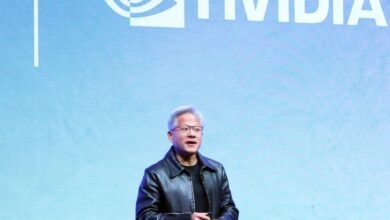
Bellwether semiconductor company Nvidia is due to present earnings after markets close on Wednesday, with all of Wall Street eager to learn whether the AI bull market still has legs.
While founder Jensen Huang will feel the heat if he cannot deliver a bullish quarterly report, the pressure this time is not nearly as intense as in August, when seemingly the fate of the entire stock market hung on his every word after several big name tech companies disappointed. At the time Dan Ives of Wedbush Securities went so far as to call Nvidia’s results “the most important tech earnings in years.”
Yet Huang is still expected to set the tone for the industry moving forward as investors will be eager for clues on the health of the generative artificial intelligence boom. Nvidia has been a chief profiteer of the investment wave, since it supplies roughly 9 out of 10 AI training chips to data centers.
Its shares have tripled in value since the start of this year, while the tech-heavy Nasdaq Composite has only risen by a third over that same period.
“We expect another jaw dropper tomorrow from the Godfather of AI Jensen that will put jet fuel in this bull market engine,” wrote Ives on Tuesday, reaffirming his underlying investment thesis. In his view, Nvidia’s bombshell-proof market share effectively means it is the “only game in town” and can expect $1 trillion or more in capex spending from customers.
That doesn’t mean that the bar isn’t rising, especially as Nvidia continues to lap its easier comparison results from previous year’s quarters prior to the GenAI boom.
Worries over booming GenAI investments flattening out
There is a growing debate around the question as to whether advancements in neural networks are starting to plateau, with the pace of innovation dropping as the vast amounts of fresh data needed to train large language models are seemingly exhausted.
Meta’s chief AI scientist Yann Lecun, one of the original luminaries in the field, warned that simply attempting to scale the models through greater volumes of chips that are more powerful and can crunch even more data is not going to be enough—only a paradigm shift in approach will suffice.
“LLMs will *not* reach human-level intelligence,” he posted to Threads last week. “New architectures are needed.”
OpenAI’s recent product launch cadence has often been cited as an example. GPT-5 is still nowhere to be seen nearly two full years since its predecessor’s launch in early 2023. Meanwhile initial plans to commercially roll out its text-to-video GenAI tool, Sora, before the year is out don’t appear realistic, especially now that chief technology officer Mira Murati has left the company.
Should Nvidia customers see dimishing returns on their investments and come to similar conclusions, it’s likely they will be more cautious with their orders moving forward.
Blackwell chips overheating
Secondly, Nvidia faces a host of questions itself around its latest generation AI training chip, dubbed Blackwell, which is effectively two AI chips sandwiched into one.
For example, the decision to make Japan’s Softbank the first customer of Blackwell raised flags. A more obvious candidate would have been OpenAI, which received the first Hopper H200 back in April—hand delivered by Huang himself.
This unusual choice may be in part because earlier reports of design problems are hampering the rollout. Tech news publication The Information revealed Blackwell chips have been overheating in server racks that have particularly high energy consumption requirements of around 120 kilowatts.
Nvidia confirmed this has required further adjustments in their installation on premise, calling it “normal and expected.”
That hasn’t entirely satisfied analysts, however. “Investors now need to add this to the list of questions,” Wells Fargo said in a research note published on Sunday.
Importantly, Blackwell is not expected to affect the fiscal third quarter results that Nvidia will report on Wednesday, but it could impact their outlook.
That’s because Huang has promised that the company should already reap several billion dollars in revenue in the current fourth quarter that ends in late January.
Finally another concern this time—entirely out of Huang’s control—is the accounting issues behind Super Micro Computer, which procures Nvidia AI chips as part of their data center hardware business.
Only earlier this year a darling of investors, a recent report by short seller Hindenburg Research has raised fundamental questions about the company’s accounting practices. Last month its auditor jumped ship entirely. Super Micro announced on Monday that it had hired BDO USA as its new auditor.
Mark Yusko, CEO and investment chief of Morgan Creek Capital with $1.9 billion in assets under management, said he was nervous when it came to Nvidia’s current valuation given the problems besetting Super Micro CEO Charles Liang’s firm.
“If they don’t have the capacity to continue to be your third largest customer what happens to your revenue growth and profit growth? We’ve seen this before with Nortel and Cisco back in 2000 and 2001,” Mark Yusko told CNBC last week. “I would be a seller.”
Nearly half of Nvidia’s revenue comes from just four major customers, the company revealed in August, creating a concentration risk for the chip supplier.
Source link




